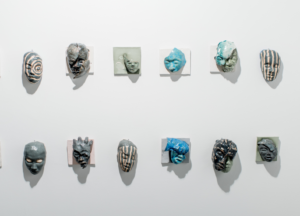September 9 – February 28, 2017
Let them eat red earth. Let them eat dirt.
by Aisha Tandiwe Bell
“Inequality: displacement, re-gentrification, fragmentation”
Bell’s work is concerned with the shifting of the individuals’ identity to compensate for and navigate unequal relationships in race, sex and class.
“One of the core concepts behind the physical manifestations of my myth making is multiple identity. Influenced by W.E. B. Du Bois’ ideas on double consciousness, my work addresses several layers of marginalization; most specifically race, sex, and class. I find that often the more marginalized the individual, the greater the propensity to code-switch or shape shift to suit specific environments. The more marginalized the individual the more the potential for multiple consciousness. This more inclusive version of Du Bois’ double consciousness can lead to a fragmentation of identity. In addition, the stress of existing in a racist, sexist, phobic, classist environment also feeds the fracturing of an individual’s identity.”
Bell’s “fractured” series, a large group of small fragmented faces fired together to form new abstracted figurative forms, acknowledges this fracturing. This series also acknowledges police brutality and the violence enacted upon black bodies. The grid-like presentation of these tiles reference both the prison industrial system and the traditional classroom setting. They become artifact, compressing several simultaneous histories into each work. “I have been using the remnants from previous performances in combination with roughly made faces, collaging the shattered with the whole and utilizing the fluxing of the glaze in the heat of the kiln to act as an adhesive, tentatively melting the shattered forms into new shifting and displaced perspectives. Materially I want to reference the geology of the area in my making utilizing red clay, iron oxides and coal.”
The exhibition title references the famous quote “Let them eat cake.” The title, both metaphoric and literal, finds its roots in our extremely unequal contemporary economics and the practice of largely lower income women and children around the world actually eating clay dirt.
“The ground that we stand on is uneven and ever shifting, literally and metaphorically…”
“My earth references are specific to my core medium: clay. I began thinking about the dirt while researching Birmingham, Alabama. Birmingham’s iron industry and coal mines fascinated me and effected my use of materials. I increased my use of iron in the production of my clay work. Also, the red clay soil rich in iron made me consider my choice of clay body. At the same time I discovered, that along with geological luck, the successful iron and steel industry had been highly dependent on leasing convicts and working the mostly black men to death in the coal mines. Leasing convicts was outlawed in the 1920s. Today it is repackaged as “employment training,” paying the prisoners as little as 2 cents per hour.”
“Making shifts, makeshifts, lean to, leans too”
Also included in the exhibition is a Tricked out Trap, based on a deadfall trap. The cardboard trap is both trap and shelter. It is also the bait. Using a series of cliché materials the cardboard box is rendered beautiful. It also becomes a home. It stands as an acknowledgement to people who have been displaced by manmade natural disaster, greed, or re-gentrification.
Aisha Tandiwe Bell is first generation Jamaican and ninth generation traceable Black American. Her parents met at City College. Conceived in Tanzania and born in Manhattan, she was Raised Bobo Shanti Rasta spending her early childhood on Bobo Hill in Bull Bay, Jamaica. Inspired by the fragmentation of our multiple identities, Bell’s practice is committed to creating myth & ritual through sculpture, performance, video, sound, drawing & installation. Bell holds a BFA and an MS from Pratt, and an MFA from Hunter College. Bell received a NYFA in Performance Art/ Multidisciplinary Work and has had artist residencies/fellowships at Skowhegan, Rush Corridor Gallery, Abron’s Art Center, LMCC’s Swing Space, The Laundromat Project and more. She has been a fellow with Diaspora Vibe Cultural Arts Incubator on International Cultural Artist Exchanges (Jamaica 2012, Surinam 2013, Antigua 2014, Guadeloupe 2015). The Museo De Arte Moderno’s Triennial 2014, The Jamaica Biennial 2014, MoCADA, The Rosa Parks Museum, CCCADI, Columbia College, and Rush Arts are a few spaces where Bell has exhibited her work. She lives in Brooklyn with her husband and two children.
59th Street Stories: the Ways of the Folk
by Tony Bingham
Birmingham artist Tony Bingham’s art making process involves engaging with the history of a place and its people, both past and present. “I engage
in conversations and go where that leads me, weaving back and forth between people and places, such as churches, cemeteries, barbershops and farmers markets, junk yards and academic institutions”. Bingham works in cast metal/cast glass sculpture, pinhole photography, drawing, printmaking and installation. His site specific/community engaged sculpture Reunion Place was commissioned by the Atlanta Committee for the Olympic Games in 1996.


